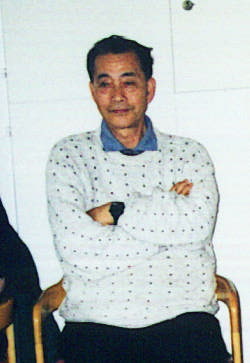Hiroatsu Sato
Crucible
Sato came of age in a country struggling to rebuild after two decades of disastrous wars. As a schoolboy, he believed in Japan’s mission in the world: to prevent China from being carved up by Western nations, to liberate colonies, to ensure unhindered access to oil, and to develop a coprosperity sphere in Asia. In 1935, his family accompanied his father, a respected professor and believer in Japan’s mission, to Manchuria where he would design a secondary education system. Sato spent most of his primary school years there, in a Japanese enclave, but gradually the reality of Japanese military tactics in China cracked the façade of idealistic intentions. After his father protested, he was fired and was forced to evacuate his family on his own through the Korean peninsula onto a boat for Japan during the height of the war. Later this was seen as a blessing in disguise because colleagues who had remained were imprisoned by the Soviets. However being uprooted, and thrust back into Tokyo, under almost daily bombardment by American B-29s, had a lasting impact on Sato’s psyche.
Sato turned 15 just after the war ended – a year short of being pressed into military service to defend the homeland against the American devils. His class was sharpening bamboo sticks to use in their defense. The myth of Japan’s invulnerability included the belief that their islands were divinely protected, proof of which they had never lost a war nor been occupied. Much of what Sato had believed in – or had bought into – was shattered. He realized that the public had been duped. Under the guise of just sounding slogans, leaders had been consolidating their power and became as ruthless, rapacious, and inhumane as those they set about replacing. That loss of innocence combined with the severe hardships of never having enough to eat, his father’s loss of employment (he was put on a list of collaborators after the war and barred from teaching) intensified his sense of struggle. His eldest sister died of tuberculosis, followed soon after by his father’s fatal stroke. The life insurance proceeds, meant to take care of the family lasted only two months because of rampant inflation. Sato had just been admitted to the prestigious Tokyo University (Japan’s equivalent of Oxford or Harvard) School of Foreign studies that trained diplomats and bureaucrats. Through the help of government subsidies, former colleagues and students of his father, and part-time jobs both Sato and his younger brother completed university. This was the crucible in which Sato’s trust, his beliefs and his resolve were formed.
LTV to India, 1956-1958
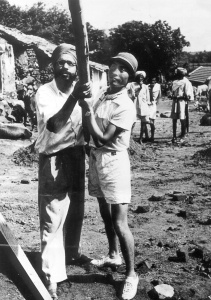
Kengeri 1956
India became his first window on the new world. Attracted by Gandhi’s practice of non-violence and a non-military approach to attaining independence, he joined a Gandhian study group in Tokyo. From this group, a Japanese parliamentarian, Madam Kora who knew international SCI, recruited promising young Japanese for LTV (long-term volunteer) service in India. Seiji Maie was the first Japanese recruited in the early 50s, and 1-2 other Japanese went out every 18-24 months. Sato began the process of applying for a visa ten years after the war ended, 1955. First he had to face censure from his extended family for relinquishing his responsibilities as the eldest son, giving up the traditional career path that his education had guaranteed, and becoming a volunteer. But his crucible had propelled him to another level of responsibility – beyond family or country to that of a citizen of the world.
Strict foreign exchange controls limited travel abroad to businessmen and government officials. Sato’s travel to India, by freighter to Calcutta, was paid for from a grant given to SCI to send 2 Japanese to the Kengeri Training Workcamp sponsored by CCIVS (Co-ordinating Committee for International Voluntary Service) in the southern state of Mysore (now Karnataka). Knowing that CCIVS had some relationship to UNESCO, Sato thought this was some high-powered meeting. He brought with him a small metal trunk and 1 metal suitcase, packed with white shirts, 2 suits, work clothes and all sorts of supplies. Instead of a high-powered meeting, he found the most diverse group of people he had ever met and he marvelled at how hard everyone worked. There was someone from the Philippines, from Indonesia, an American couple, Henriette from the Netherlands (the other SCI LTV), Hans Peter Muller, Jean Bazinet, Indra Paul Singh, Indian SCI member and teacher, as part of the assemblage. After the workcamp, CCIVS took them on a study tour, introducing them to other projects and tourist sites. A factor that obviously struck Sato then, as he referred to it often, was the range of contacts – from very high government officials to lowly farmers – from lavish receptions to a tumbler of hot milk. He learned to be at ease in all situations and find the common humanity – often harder with officials. It was a life-long lesson.
In the `50s the LTV’s role was to be in all the workcamps organized, and be available to give talks to local groups and student groups but in between one could pursue their own program. Sato spent time at Sevagram (Gandhi’s Ashram) and also joined a month-long walk (pady yatra) led by Vinoba Bhave who followed Gandhian principles. He was collecting land, the Bhoodan movement, to redistribute to the landless and his appeal to landowners was to treat him as another son. Sato was absorbing rural India, but felt a big handicap in not speaking Hindi or fluent English. The utility of a workcamp was reinforced for him because there language did not matter.
In March, 1957 at a workcamp in Orissa state I (his future wife) joined up with the SCI team, having finally been granted a visa, and met Sato for the first time. Although he had majored in English studies at university, his spoken English was very limited. Later he told me listening and speaking English was his most tiring activity but trumping that was his frustration at not being able to communicate. Since I had spent some time in England with another SCI Japanese with very poor English, somehow I was used to the accent and incomplete sentences. Sato wanted to participate in some of the evening programs beyond singing ‘Moon Over Ancient Castle’ in Japanese, when we shared information about our countries. One-to-one, without time pressure, he said it was easier to express himself, so he requested that I take notes and then present Japan to the other workcampers. With increased opportunity and my patience, he became more fluent and soon dispensed with a spokesperson and the hint of his persona as Asian spokesperson in SCI meetings emerged.
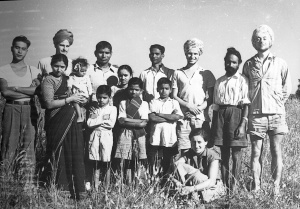
Service in Warora Anandwan 1956
In 1956-57, LTVs were given a pocket allowance of Rs. 20, around $4 monthly and when travelling a food allowance of Rs. 2/8 annas (before going on the decimal system). Sato was a smoker and virtually all of his pocket money went to cigarettes. At that time there was a lot of counterfeiting both of coins and bills so one needed to learn how to test coins and examine bills. Unfortunately Sato had been given a Rs.20 bill that all the vendors refused, but he was desperate because he needed that money. We hatched a plan that the next time we were in Delhi and in Connaught Place where one could find nice restaurants that were dimly lit, we would pass on this bill. Our plan was successful and the relief and happiness remain vivid memories.
Another vivid memory was crossing no-man’s land into Pakistan in 1957. Foreigners could still travel overland from Europe to India and some took buses or cars, or even hitchhiked, though the Kyber Pass was noted to be very dangerous. However, there was no direct route between India and Pakistan, so when Ethelwyn Best sent Sato and myself to Pakistan as the international representatives for a workcamp, we had to take a train to the border. Then we had to get down and walk across an empty patch to a guard house, and show our visas to the guards. We were the only ones, so over cups of tea we were told what to see and told to separate as I must now travel only in the Ladies Compartment. In Karachi we were recipient of the legendary hospitality and heard the reciprocal hardships caused by the Partition that uprooted so many people. There was a small, but vibrant SCI group with some returned from Europe, and there was hope for an exchange with India.
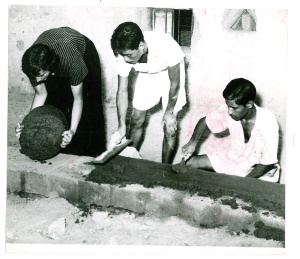
Phyllis and Sato in Karachi 1957
At our last workcamp in Srimadhopur (Rajasthan), a number of significant things happened. First of all, our replacements had arrived – Joop Koning from the Netherlands, Jean Sueur from Switzerland and Henri Majewski from France – and we realized that this ever-unfolding adventure was drawing to a close. This rare period of a somewhat vagabond existence was ending. We were valued just for ourselves or at least because we were foreigners, so we fulfilled expectations just by being. ‘pressure-free’. Additionally’ we felt we were old hands – having learned to bargain, how to stake out the wooden luggage racks as a berth on long train journeys, to carry water in earthen jugs to cool it. Sato said that he realized how little one needed to live on, especially in a tropical climate and that he could be at home in a variety of circumstances. Second, was the first contact with Valli Chari in her first workcamp. Sato was impressed by her ability to express herself without being too aggressive – independent but still Asian. She carried an enthusiasm for new concepts and a special energy that also caught the visiting International Secretary’s, Dorothy Abbott Guiborat, attention. Sato also caught Dorothy’s attention. She encouraged Sato to organize a workcamp in Japan upon his return.
In the final weeks of our team in India, I had decided to return home via the Pacific, instead of Europe. We left Calcutta together bound for Yokohama on a British-India ship; he travelling deck class but with an upgrade to take Chinese meals, and me allowed no lower than second class, but with a choice of Chinese meals. Rangoon (still open to foreigners), Penang, Singapore and Hong Kong were our ports of call and helped us transition to the fast modernizing post-war Japan. He became a tour guide of Japan for me prior to my departure for the States. We both decided that this adventure could not end so I signed up to return to study Japanese in the fall, and married on my return.
SCI in Japan
Four months after he returned to Japan in 1958 Sato organized the first small workcamp, with only Japanese participants, on a small island in Tokyo Bay, an overnight boat trip from Yokohama. The National Self-Defense Force (an army was prohibited in the Constitution, but a Self-Defense Force was permitted) selected an uninhabited area of the island to build a missile testing site. Islanders were deeply divided, and various political parties sent in outside organizers for protests. Sato found that child care while women worked in the fields was an issue, and the group collaborated in getting land for a kindergarten, and in subsequent workcamps worked on building a playground and assisting. Families from both sides of the divide were engaged in the venture and cooperation cooled tempers. Students who attended were impressed by this constructive, practical activity and formed the core of later work in Japan. In September after that workcamp, I came to study Japanese and we married in Tokyo.
Sato continued to organize a variety of workcamps, especially Leadership Training camps and even wrote a leader’s handbook, later translated into English, so there was a pool of leaders. Taking from the French Branch’s example of relief work, after an earthquake in northern Japan, SCIers raised money at railway stations and sent a team to help. The first Asian Secretary, Devinder Das Chopra, visited the Group in 1961 after the birth of our second daughter and subsequently arranged for Indian MTVs to come – Atma Singh and Kurian Paul were among those and we recruited among American students in Japan, thus gradually internationalizing the camps. Around this time students from South Korea came to participate in Japanese workcamps, and eventually these experienced ones began to organize activity in South Korea. Valli Chari, from the Asian Secretariat, also visited in 1963 and stimulated interest, promoting an exchange of volunteers.
During this period our home was the gathering place and contact point, even after Japan attained Branch status – 1962 I think. With a growing family we supported ourselves by teaching English in our home, making subtitles for “B” Japanese movies exported to Hong Kong and translating scripts for dubbing American TV programs. We could set our own schedule, and Sato was able to go to workcamps and help the new Secretary, Fumi Ono, who came daily to our house. Increasingly, LTVs who had finished their time in India, took the MM (Messargeries Maritime) boat line on to Yokohama – like Thedi von Fellenberg, Elizabeth Crook, Cathy Hambridge Peel and Ann Smith Kobayashi (from Thailand).
Asian Secretary, 1965-1968
Once Devinder and Valli decided to move on from the Asian Secretariat, Sato was approached. A month after our third child was born, in 1964, he set off by boat to Vladivostok, across Siberia to France for the November International Committee Meeting (ICM) where his appointment was finalized and he met the International Secretary, Ralph Hegnauer. Because of tensions between India and Pakistan and Ceylon, visas to travel to each other’s country were difficult so the ICM asked Sato to explore setting up an office outside of India. Since Devinder had made good contacts and initiated workcamps in Malaysia, that seemed a promising location. First, Sato returned by boat, via India for a handover of important information, and stopped off in Taiwan to explore some contacts there. For the next six months the office operated out of our home, as we awaited a response from the government in Kuala Lumpur for residence visas. Finally, a letter came suggesting that we come on a temporary visa and pursue it in person. We disembarked in Singapore on the day it separated from Malaysia, in 1965, with confused custom officials finally accepting our Malaysian tourist visas.
Thanks to a grant from an American foundation to promote exchange of volunteers within Asia, there were resources to stimulate activities. It also meant that Sato was on the road (strictly speaking air as our toddler would point to a plane and say ‘Dada’ from seeing him off on planes) half of the year. There was promising activity in Thailand, Nepal and Ceylon, with cyclone relief work in East Pakistan, in addition to all the usual SCI meetings. Fortunately Masahiro Shintani was appointed Assistant Asian Secretary in December 1966, spreading out the office work and travel. Just 3 months after his arrival, the Malaysian cabinet finally made a decision not to permit the Asian Secretariat to establish an office in Malaysia. They wanted SCI to disavow work with conscientious objectors, because they were concerned that pacificism meant communism (this was not long after the British had quelled a communist insurgency there) and questioned Sato’s travel to South Vietnam where he explored work with Buddhist groups. As an American I could enter Singapore without a visa so was sent to talk with Singapore officials. Being a duty-free port, they had no problems with SCI and immediately granted us permission. The same day I found a lovely old house on stilts, with servants quarters that could be used for an office, about 10 miles west of city center. The office was relocated within two weeks and proved much more accessible. Singapore was a port of call for the Messargeries Maritimes boats so volunteers could easily drop in.
After visiting so many SCI long-term projects, Sato began to question their inherent structure, with its built-in turnover creating a distance from the local community. An alternative formulated in his mind for an agricultural project. He envisioned permanently settling on the project site in the role of a “good neighbor” to model new agricultural techniques so that development would occur organically. Resigning in early 1968, succeeded by Navam Appadurai, with Masahiro remaining in Singapore, Sato went to India in late 1968.
Visionville, 1968-1977
Sato found land 17 miles from Bangalore and Visionville was formed. He and other SCI LTVs established an Asian Regional Training Center at the farm – a big name for a program that gave orientation to incoming and outgoing M/LTVs and hosted workcamps. We were also fortunate to have LTVs working with us on the farm plus the initial assistance of Kurian Paul, and looked forward to the day when two other couples, the Seshans and Parashiva Murthy plus family, were able to join in a co-operative venture.
We started from scratch: having a temporary house built, drilling a well, making irrigation facilities, bringing in electricity, etc. Aided by the fruits of a steep learning curve, the overgrazed, eroded land was gradually transformed into a working enterprise. Over time it seemed that trust was being built, and small effects were seen, validating Visionville’s initial premise. However, other forces were working under the surface as the traditional power structure began to feel threatened. Month after month passing by the unfinished one-room school in a nearby village, Sato inquired about the hold-up. He was told money had run out – actually had been siphoned off by a corrupt leader. Sato proposed to provide labor through a workcamp if the leader would raise some money for their expenses. It was completed but also it had offended a powerful person. Rumors were planted that Visionville operated a counterfeiting press, and that with the steady stream of foreigners observed, it was a CIA outpost. That fed into the paranoia caused during the Emergency declared by Indira Gandhi. Policy was to deny visas to non-government sponsored individuals, especially those living in village areas so we got a letter telling us to leave with only what we could carry.
After denial of an appeal to the Home Ministry, we left Visionville in late November of 1976. As we prepared to board our plane in Bangalore, on the other side of the glass partition, the Parashiva Murthy family was walking to baggage claim. Their move from Canada to India had been in the works for over three years, and they decided to come despite our impending departure. Martin and Juliet Pierce were the ‘Visionville liaison team’ and transmitted the wheres and whys of daily operations. Subsequently the whole property was sold to a poultry factory which later went bankrupt and now the land has been reclaimed by bushes.
Sato looked back on Visionville as a rich learning experience and felt that the ‘tuition’ paid was well worth while, infinitely better than university. Aside from practical learning, and village customs, the living and working together with so many people willing to question one’s own and other’s foibles created a rare atmosphere. There was no place to hide or disappear. Crops and livestock are relentless taskmasters. In retrospect, being in touch with nature’s cycles, yet stimulated by other seekers, meant we were provided an environment never replicated in urban settings.
Before his death, Sato also likened the rise and fall of Visionville, as well as many other things he had been passionate about, to the Hindu concept of ‘lila’. The ‘play of life’ reflected in building sand castles at the sea shore that are wiped out by the incoming tide and built again the next day. The thing that remained, however, was his feeling of connectedness to other people. Some were brief encounters, others were paths that crossed again and again. We all enrich each other’s lives in ways unbeknownst to us, and a lifelong association with SCI has been a good catalyst for that phenomenon.
Conclusions
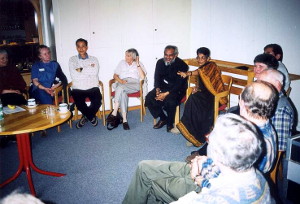
Sato, Phyllis, Muzammil and Valli in Herzberg 1998
Being accurate as to how Sato distilled his long SCI involvement is a challenge because either they are intertwined with mine or the echoes of what he repeated over and over until it finally became mine. As trite as it may sound, the ‘Deeds, not words’ became our organizing principle and has remained a solid lifelong principle. The mechanism of a workcamp also has not lost its appeal as a tool of bringing people together to do something practical. Contrary to those who said that projects were hard to find in a modernized society, Sato felt there was more need than ever. In the U.S. he led its first workcamp with a Navajo community and one in a Philadelphia ghetto with tense racial divides. With increasing polarization today, I know Sato would be sure to find a project to bring Muslim, Jews and Christians together. He remained fully committed to the reconciliation roots of early SCI, believing that working and sharing meals together in challenging conditions was vital in combating the propagandizing media that demonizes the ‘other’. Even if it is only a small number, the effect can gradually expand mirroring Pierre Cérésole’s dictum: “If it takes a thousand steps, begin the first one today”.
On an organizational level, Sato remained active as a member of the International Committee and International Executive Committee during various waves of issues. Sato, along with Valli, was a vocal critic of ‘Eurocentrism’ within SCI. This was manifested by its willingness to send large numbers of Europeans to Asia and Africa (because government grants were there) without receiving volunteers from those countries. A token exchange program was not enough in his opinion. He often faulted European branches for looking at the world through its own prism, rather than as an international body. He was very sensitive to unspoken assumptions of superiority or subtle paternalism that he felt lay just beneath the surface in attitudes towards Asia.
During the period when many SCI Branches and Commissions began taking what he saw as ‘sides’ and were looking at injustices caused by other countries rather than at the injustices in their own backyard; he emphasized the principle of reconciliation. Some called this being a ‘purist’, but Sato thought it was an immutable principle of SCI. He recognized that SCI needed to be forever evolving and adapting to changing conditions such as the move away from the initial ‘pick and shovel’ workcamps in the `30s to the work-study camps in the mid-`50s and long-term projects. However there were certain core principles that needed to be retained, or SCI’s reason to exist would dissolve into being a generic social gathering. A unique aspect of SCI that Sato found valuable was its national structure. The Secretaries and committees were from that country, so knew its customs and ways of doing things. Yet these national branches did cooperate. He used to contrast it with the Quaker Centers in India, Japan or Singapore. Their members were nationals, but the head was usually British or American and followed their mother country’s structure. Initially aid organizations followed this pattern, and he felt SCI had something to offer because its local staff had an intimate knowledge of local conditions.
As an individual Sato was forever marked in his formative years by how he had been lied to by politicians and by Japan’s defeat. In his last years he said, however, that he was still hopelessly Japanese – in his training and culinary preferences. Yet he also felt that he was a citizen of the world and could be at home anywhere. His SCI involvement had become his new crucible.



